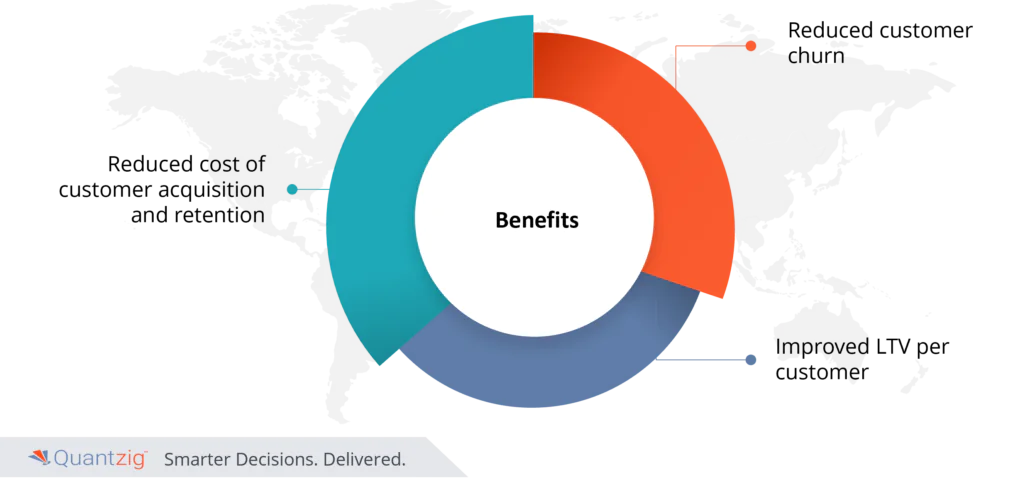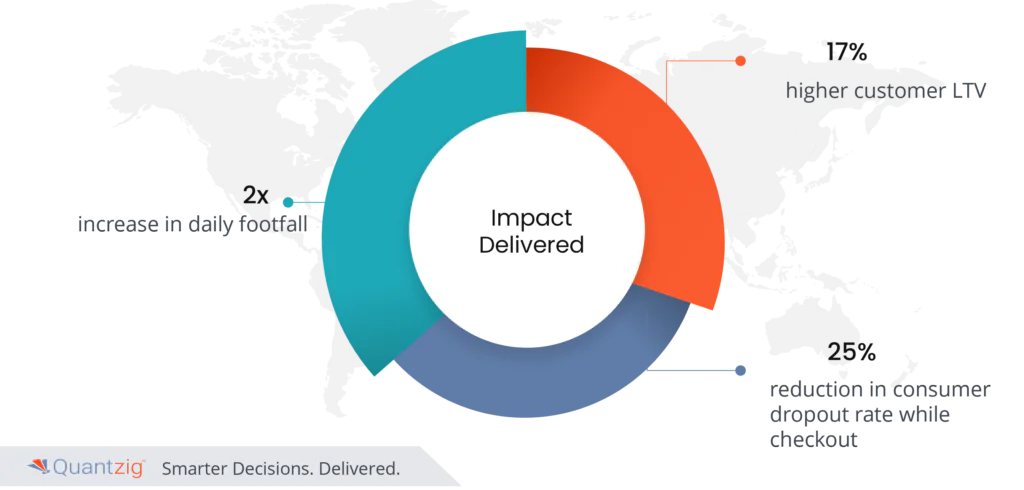Author: Associate Vice President, Analytics and Data Strategy, Quantzig.
Table of Contents
Evolution of Omnichannel Marketing
Omnichannel marketing has evolved from a focus on merely having multiple channels to a more sophisticated approach that emphasizes integration and personalization. Initially, the goal was to have a presence across various platforms; now, it involves creating a unified and personalized customer journey. Advances in data analytics and technology have enabled marketers to track and analyze customer interactions across channels, leading to more targeted and relevant marketing efforts.
Today’s omnichannel marketing strategies prioritize delivering consistent messaging, personalized offers, and a seamless experience, reflecting the increased expectations of modern consumers for a fluid and connected brand experience. But what exactly is it?
What is Omnichannel Retail?
Omnichannel retail refers to a strategy that integrates all retail channels—such as physical stores, online platforms, mobile apps, and social media—into a unified customer experience. This approach ensures that customers receive a consistent and seamless shopping experience, regardless of the channel they use. Omnichannel retail focuses on connecting these diverse touchpoints to provide a cohesive brand experience, enabling customers to interact with the brand, access products, and make purchases in a way that suits their preferences. This integration enhances convenience, boosts customer satisfaction, and drives greater engagement and sales.
Why is Omnichannel Commerce Valuable for Retailers?
Omnichannel commerce is valuable for retailers because it creates a seamless and cohesive shopping experience across multiple channels, meeting customers wherever they are. By integrating online and offline touchpoints, retailers can enhance customer satisfaction, boost brand loyalty, and increase sales opportunities. This approach allows for better data collection and analysis, leading to more personalized marketing and improved inventory management. Additionally, omnichannel strategies from experts like Quantzig help retailers stay competitive by adapting to evolving consumer preferences and shopping behaviors, ultimately driving growth and profitability.
Book a demo to experience the meaningful insights we derive from data through our analytical tools and platform capabilities. Schedule a demo today!
Request a Free DemoSteps for Building an Omnichannel Strategy
Understand Customer Behavior:
Analyze customer data to gain insights into their preferences, shopping habits, and interactions across different channels. This helps in tailoring the omnichannel approach to meet their needs effectively.
Integrate Channels:
Ensure all sales and communication channels are connected and synchronized. This involves aligning inventory systems, customer service, and marketing efforts to provide a unified experience.
Create Consistent Messaging:
Develop a cohesive brand message and experience across all channels. Consistent messaging reinforces the brand identity and ensures customers receive the same information and service, regardless of the channel they use.
Leverage Technology:
Utilize tools and platforms that facilitate seamless integration and data sharing among channels. Implement customer relationship management (CRM) systems, data analytics, and automation to enhance efficiency and personalization.
Monitor and Adapt:
Continuously track the performance of your omnichannel strategy through analytics and customer feedback. Be prepared to make adjustments based on evolving customer needs and market trends.
Importance of Shopper Insights and Omni-Channel Targeting creating value for Retailers

Reduced Cost of Customer Acquisition and Retention:
Bringing down the expense of client acquisition and retention is essential for sustainable business growth. By leveraging consumer insights and implementing a strategic omnichannel strategy, retailers can optimize their retail marketing efforts. Understanding customer behavior helps in identifying the most effective multichannel platforms and creating targeted campaigns. This accuracy ensures that each marketing dollar is effectively used, reducing the cost per acquisition.
Reduced Customer Churn:
Customer churn, or the rate at which customers stop engaging with a retailer, directly impacts revenue and reputation. Consumer insights, gathered from analyzing customer behavior, reveal patterns indicating potential churn. Omnichannel targeting enables timely interventions, such as personalized offers or proactive customer service, aimed at retaining customers at risk of leaving. Addressing the root causes of churn through targeted communication improves the customer experience, fostering loyalty and reducing churn rates. Retaining existing customers not only maintains revenue streams but also builds brand advocacy, attracting new target consumers through positive word-of-mouth.
Improved Lifetime Value (LTV) per Customer:
The lifetime value (LTV) of a customer represents the total revenue a business can expect from a customer throughout their entire relationship. Consumer insights and a well-executed omnichannel strategy are crucial in enhancing LTV. By understanding customer preferences, organizations can anticipate future needs, enabling targeted cross-selling and upselling efforts. This approach improves the overall omnichannel retail experience, meeting consumer expectations and optimizing the omnichannel journey. For omnichannel shoppers, integrating insights across both multichannel selling and omnichannel strategies ensures a more personalized and valuable shopping experience.
Get started with your complimentary trial today and delve into our platform without any obligations. Explore our wide range of customized, consumption driven analytical solutions services built across the analytical maturity levels.
Start your Free Trial TodayThe challenges of Shopper Insights and Omni-Channel Targeting creating value for Retailers
Numerous clients experience a horde of difficulties in the present competitive market. First and foremost, lack of robust identity resolution practices hampers organizations’ capacity to make a brought together perspective on their clients across different touchpoints, prompting divided experiences and less successful promoting procedures. Furthermore, a low customer repetition rate implies a battle in holding clients, frequently because of lack of commitment or neglected concerns, bringing about lost income potential and diminished brand reliability. Thirdly, a significant expense of client securing features wasteful marketing procedures or channels, where significant ventures neglect to yield proportionate returns. In conclusion, the shortfall of an extensive consumer data stage restrains the client’s capacity to outfit the force of information for key direction. A concentrated stage is crucial for aggregating and analyzing client data, empowering organizations to infer noteworthy bits of knowledge, improve client encounters, and streamline showcasing efforts successfully.
Key Benefits:

- Reduced cost of customer acquisition and retention:
Reduced cost of client obtaining, and maintenance refers to the effective utilization of assets and procedures to draw in and keep clients. By upgrading marketing efforts, organizations limit costs related to procuring new clients. All the while, customized maintenance systems guarantee client dedication, reducing expenses connected with consistent client turnover, bringing about huge investment funds, and further developed benefit.
- Reduced customer churn:
Reduced client churn implies holding more clients over the time. By further developing items, administrations, and client encounters, organizations can keep clients from changing to contenders. Decreasing churn prompts more prominent client dependability, expanded income, and a more grounded brand notoriety, stressing the significance of keeping up with existing client connections for long-term business achievement.
- Improved LTV per customer:
Further developed LTV (Lifetime Value) per client means boosting the complete income a client produces all through their relationship with a business. Accomplished through customized contributions, uncommon assistance, and client reliability drives, it reflects expanded client spend, repeat buys, and long-term commitment. Improving LTV guarantees manageable productivity, featuring the meaning of supporting enduring client connections.
How Quantzig helps with Omni-channel targeting?
Here’s the shortened vertical table:
| Category | Details |
|---|---|
| Client Location | Europe |
| Client Problems | Disconnected data hindered a unified profile. Challenges in retaining clients and encouraging repeat business. High marketing costs made acquiring new clients expensive. Ineffective aggregation and analysis of customer data. |
| Solution Provided | The Consumer Data Platform enabled precise targeting, the Marketing Automation Tool boosted engagement, Behavioral Models refined store layouts, and AI-Based Models improved personalization. |
| Impact Delivered | – 2x increase in daily footfall – 17% higher customer LTV – 25% reduction in dropout rate during checkout |
Challenges Faced by the Client:
- Lack of Identity Resolution Practices: The absence of identity resolution practices hindered the creation of a unified customer profile. Without an effective system to connect data from various touchpoints, the company struggled to comprehensively understand customer behavior. This fragmentation led to disconnected insights, impeding personalized marketing efforts and weakening the ability to deliver a consistent omnichannel retail experience across different channels.
- Low Customer Repetition Rate: A low customer repetition rate indicated difficulties in retaining clients over time. This challenge reflected ineffective engagement, lack of personalized experiences, and poor customer satisfaction, resulting in sporadic or one-time purchases. Addressing this issue required enhancing customer interactions, improving product/service quality, and implementing loyalty programs to encourage repeat business and foster long-term client relationships.
- High Cost of Customer Acquisition: The high cost of customer acquisition revealed that acquiring new clients was financially challenging. The costs associated with retail marketing, promotions, and advertising outweighed the revenue generated from new customers. This situation demanded cost-effective strategies and efficient targeting to maximize return on investment and ensure sustainable business growth.
- Lack of Consumer Data Platform: The absence of a consumer data platform created a significant gap in the client’s ability to harness strategic customer data. Without a unified platform, the company struggled to aggregate, analyze, and utilize customer information effectively. This deficiency impeded personalized marketing efforts, comprehensive customer insights, and strategic decision-making, impacting the client’s competitiveness in the data-driven market.
Omni-channel Solutions from Quantzig:
- Comprehensive Consumer Data Platform with Identity Resolution Engine for Omnichannel Targeting: Quantzig implemented a robust consumer data platform with an identity resolution engine. This integrated system provided a unified view of customer data across multiple channels, enabling precise omnichannel targeting and personalized experiences. By resolving customer identities, the company enhanced its omnichannel marketing efforts, delivering tailored content and promotions, boosting engagement, and driving higher conversion rates and revenue.
- Shopper Insights-Based Marketing Automation Tool: Quantzig’s shopper insights-based marketing automation tool revolutionized marketing strategies. By leveraging advanced data analytics, it deciphered customer behaviors, preferences, and trends. This actionable intelligence allowed the company to automate personalized marketing efforts, improving engagement and conversion rates. It ensured targeted communication, maximizing marketing ROI, and fostering enduring customer relationships in a competitive market.
- Consumer Behavioral Models to Support Store Layout Planning: Quantzig employed consumer behavioral models to refine store layout planning. Analyzing customer behavior data, such as foot traffic patterns and product interactions, enabled the company to design store layouts that enhance the customer experience, improve product visibility, and boost sales. This data-driven approach ensured that stores were optimized according to customer preferences, maximizing engagement and revenue.
- AI-Based Next Best Action Models for Personalized Omnichannel Targeting: Quantzig introduced AI-based next best action models, transforming personalized omnichannel targeting. Utilizing artificial intelligence, these models analyzed vast datasets to predict customer behaviors and preferences. Tailored recommendations guided marketing strategies, ensuring precise customer engagement across all channels. This solution improved customer experiences, increased conversions, and optimized marketing ROI, marking a significant advancement in data-driven marketing efficiency.
Impact Delivered:

- 2x increase in daily footfall
- 17% higher customer LTV
- 25% reduction in consumer dropout rate during checkout
Experience the advantages firsthand by testing a customized complimentary pilot designed to address your specific requirements. Pilot studies are non-committal in nature.
Request a Free PilotConclusion:
In conclusion, the combination of insights and omni-channel targeting focusing on is upsetting the retail scene. By digging into client ways of behaving and preferences, organizations gain significant bits of knowledge, considering customized and consistent shopping encounters. Omni-channel focusing on guarantees predictable cooperations across on the web and disconnected stages, cultivating client devotion. This collaboration doesn’t simply improve consumer loyalty; it makes significant incentive for retailers. With a profound comprehension of their customers and key focusing on, retailers improve showcasing endeavors, support client maintenance, and boost income. In this time of dynamic buyer requests, the combination of customer experiences and omni-channel procedures isn’t simply an upper hand; it’s a need for retailers making progress toward persevering through outcome in the consistently developing business sector.



